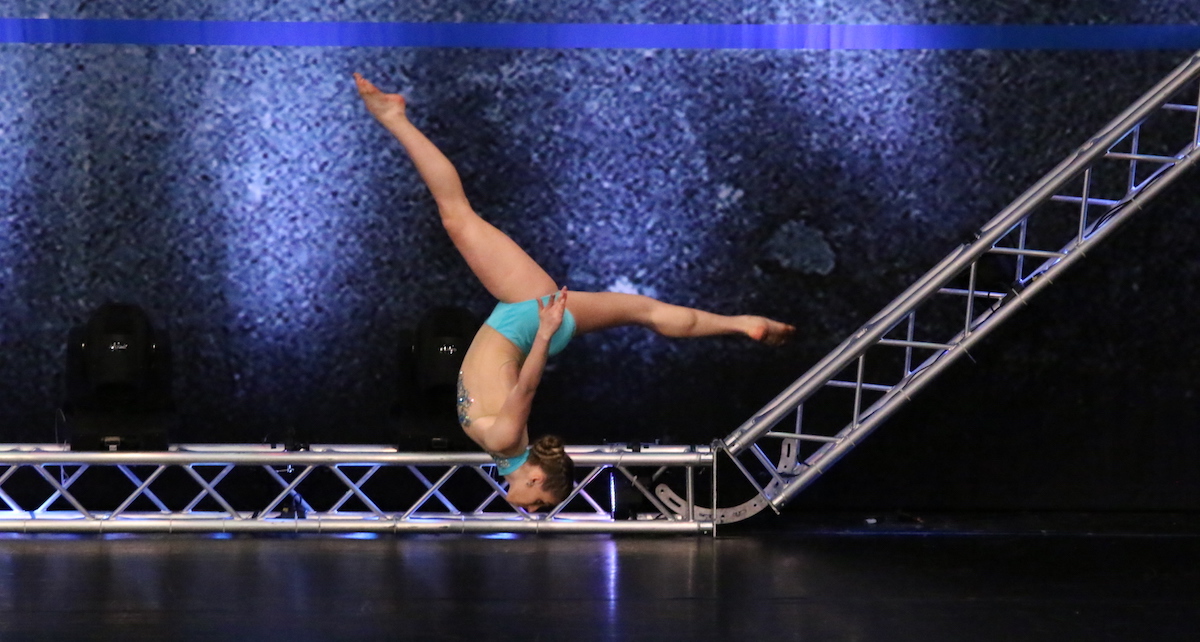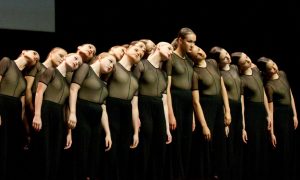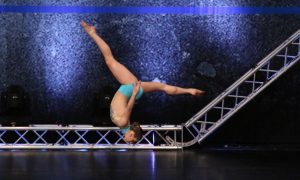Choreography season is upon us, and with the flood of new ideas comes the need for something to compliment the dances being taught. Although turn sections and leaps may be helpful, the finishing touch that seems to be popular, especially now, is acrobatic tricks. From the simplest front somersault to a more advanced back tuck, the fundamentals taught with each skill can strengthen a dancer’s body, thus giving them a stronger facility. The popularity of training in acro has grown throughout the years and in the competitive scene with most competitions offering an acro category. Although these tools are at the fingertips of dancers and studio owners, the question still remains: should I take acro?
For Groove Dance Competition judge Jill Lazzini the answer is clear. “I believe dancers should take acro for many reasons,” she says. “Acro helps develop and improve core strength, spine stability, upper body strength, control and flexibility. All of those things will help in other areas of dance, but spine and core strength are helpful in all areas of life.”
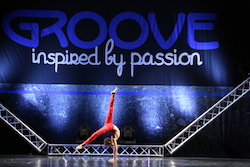
Photo courtesy of Groove Dance Competition.
It took a little more time for the co-director of A Step Ahead Performing Arts Studio, Ashley Medina, to open up to the idea of acrobatic training. Over the past year, she says she has become more of an advocate and has introduced acro training into her studio’s curriculum.
“While it will never be the backbone of dance the way ballet is, the dance world is constantly evolving, and I do believe that having good training in the basics of acro is beneficial,” says Medina.
With some of the benefits such as developing a strong core, spine and focusing on flexibility, the age in which a dancer is introduced to acro can play a big role in how well they develop their skills.
Medina says, “We introduce acro starting at preschool age, and of course the class structure is adapted to be appropriate and safe for that age group.”
“If following a safe, age appropriate progression, three to four years of age is a good age to introduce basic beginner acrobatic skills,” Lazzini explains. “You can do it at any age, but safety is a key factor. It takes a patient kid, which makes the process easier.”
Like any other sport, acro has its risks, and with that comes risen fears, especially with elements that are not taught or executed properly. The dancer’s safety and proper form during any skill is crucial in order to prevent injury. This is where hiring certified instructors serves as a safeguard when dancers are in the early stages of learning acro.
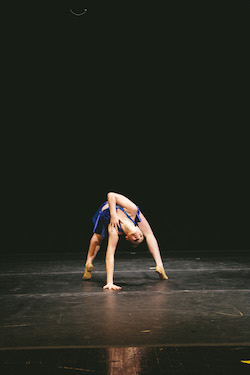
A dancer from A Step Ahead Performing Arts Studio. Photo by James Jin.
Although her fears are quite minimal at the moment, Medina shares, “The danger that has always existed is dancers trying to teach themselves acrobatic tricks at home and getting hurt, because they do not have the knowledge base or someone to properly spot them. We want our students to understand why progressive training is important, how following the building blocks of the curriculum will benefit them in the long run, and what they can do now to safely work toward those goals like aerials and back handsprings.”
Lazzini shares a similar outlook on her fears and dangers as a judge watching dancers throw in tricks they are not trained properly to execute. The recurring theme of safety rings true for her as well.
“As a judge, one danger I see that worries me is seeing young dancers throwing tricks that they aren’t ready for,” she says. “It makes me nervous. However, if dancers learn skills in an orderly fashion, they will be safe moving on from one skill to the next. When basic skills aren’t mastered before a dancer moves on, injury may occur.”
Acro tricks in dances have turned into a popular trend in various styles including but not limited to lyrical, tap, jazz and hip hop. Even though some tricks such as aerials or front walkovers lend themselves to dances, inserting these tricks just for the “wow” factor is something that both Medina and Lazzini don’t favor too much.
“This is where my opinion may differ from many dance instructors, but I am personally not a fan of acrobatic elements used heavily in jazz, lyrical, contemporary, and certainly not in ballet,” Medina says. “I believe that if an acrobatic element is included in a routine, it should support the intention of the piece and not distract from it.”
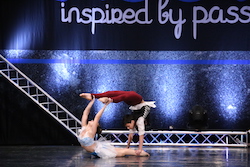
Photo courtesy of Groove Dance Competition.
In response to this trend, Lazzini says, “There are some styles, choreography or songs that lend themselves to various acro skills, but they should not be forced into a routine. Certain styles don’t offer themselves to a back handspring, for instance. The audience will enjoy the acrobatic elements more if they fit the styles or moments in a routine.”
When done in the right progression and appropriate time, learning acro skills can open the door to more versatility in a dancer’s training. Along with that versatility comes a better understanding of one’s own body and weaknesses that need work. Nevertheless, acro skills, when used safely and by means of complimenting a dance, can serve as a great finishing touch to a variety of routines. By implementing these points in progression, dancers will in return be more employable later on in their career.
By Monique George of Dance Informa.


